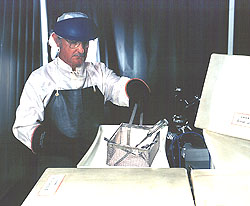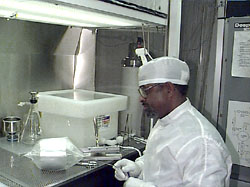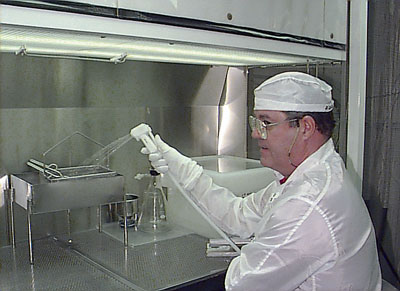Really Clean Water . . . The UPW System
by Judy Allton
Lockheed Engineering & Science Services Company
 Not for drinking, but for cleaning
and rinsing the sample handling tools and containers. Since the
early 1970s sample tools and containers were cleaned first with
mild surfactant solution in an ultrasonic device. Sometimes an
acid rinse was used to remove traces of lead from the manufacturing
process. But all tools were finally rinsed with distilled Freon
and dried. As a fluorocarbon, Freon was ideal because it did
not leave a hydrocarbon residue. Freon was a good solvent for
non-polar contaminants, it was non-flammable for added safety,
and it dried rapidly removing moisture from the items. Alas,
Freon's side-effect of destroying ozone in the upper atmosphere,
led the curator to replace Freon cleaning with with Ultra Pure
Water (UPW) in 1994.
Not for drinking, but for cleaning
and rinsing the sample handling tools and containers. Since the
early 1970s sample tools and containers were cleaned first with
mild surfactant solution in an ultrasonic device. Sometimes an
acid rinse was used to remove traces of lead from the manufacturing
process. But all tools were finally rinsed with distilled Freon
and dried. As a fluorocarbon, Freon was ideal because it did
not leave a hydrocarbon residue. Freon was a good solvent for
non-polar contaminants, it was non-flammable for added safety,
and it dried rapidly removing moisture from the items. Alas,
Freon's side-effect of destroying ozone in the upper atmosphere,
led the curator to replace Freon cleaning with with Ultra Pure
Water (UPW) in 1994.
 Technical development of UPW cleaning
was led by the semiconductor industry. Very pure water is an
excellent solvent. Purity of the water is continually measured
by the resistivity of the water. Curatorial UPW exceeds 18 MW-cm.
Other measures of cleanliness performed on batch samples include
inorganic ions (1 ppb level), total organic carbon (100 ppb level),
and culturing/endotoxin tests for microorganisms (none confirmed).
The team is in the process of upgrading the batch testing procedures.
Technical development of UPW cleaning
was led by the semiconductor industry. Very pure water is an
excellent solvent. Purity of the water is continually measured
by the resistivity of the water. Curatorial UPW exceeds 18 MW-cm.
Other measures of cleanliness performed on batch samples include
inorganic ions (1 ppb level), total organic carbon (100 ppb level),
and culturing/endotoxin tests for microorganisms (none confirmed).
The team is in the process of upgrading the batch testing procedures.
How is ultra pure water created?
Starting with water purified by reverse osmosis, water is passed
through 5 µm filters, cation/anion absorbers and then into
a continually circulating closed loop. In this loop are filters
to remove particles < 0.2 µm, an ultraviolet source to
kill microorganisms, and organic carbon absorbers. The important
concept is to keep the water continually moving with no "dead"
space for non-circulating water, for that is where microbes can
grow. Because pure water is such an agressive solvent, the plumbing
for the entire system is made of polyvinylidene fluoride (PVDF),
a non-leaching material.
Finally, some UPW is drawn off the
loop and heated to 160° F just before the water is used to
intensively rinse the tools. The tools are then transferred to
an oven with highly-filtered air circulation for drying.

Ultra pure water is just one technology
used in the curatorial cleaning process.
 Not for drinking, but for cleaning
and rinsing the sample handling tools and containers. Since the
early 1970s sample tools and containers were cleaned first with
mild surfactant solution in an ultrasonic device. Sometimes an
acid rinse was used to remove traces of lead from the manufacturing
process. But all tools were finally rinsed with distilled Freon
and dried. As a fluorocarbon, Freon was ideal because it did
not leave a hydrocarbon residue. Freon was a good solvent for
non-polar contaminants, it was non-flammable for added safety,
and it dried rapidly removing moisture from the items. Alas,
Freon's side-effect of destroying ozone in the upper atmosphere,
led the curator to replace Freon cleaning with with Ultra Pure
Water (UPW) in 1994.
Not for drinking, but for cleaning
and rinsing the sample handling tools and containers. Since the
early 1970s sample tools and containers were cleaned first with
mild surfactant solution in an ultrasonic device. Sometimes an
acid rinse was used to remove traces of lead from the manufacturing
process. But all tools were finally rinsed with distilled Freon
and dried. As a fluorocarbon, Freon was ideal because it did
not leave a hydrocarbon residue. Freon was a good solvent for
non-polar contaminants, it was non-flammable for added safety,
and it dried rapidly removing moisture from the items. Alas,
Freon's side-effect of destroying ozone in the upper atmosphere,
led the curator to replace Freon cleaning with with Ultra Pure
Water (UPW) in 1994.
 Technical development of UPW cleaning
was led by the semiconductor industry. Very pure water is an
excellent solvent. Purity of the water is continually measured
by the resistivity of the water. Curatorial UPW exceeds 18 MW-cm.
Other measures of cleanliness performed on batch samples include
inorganic ions (1 ppb level), total organic carbon (100 ppb level),
and culturing/endotoxin tests for microorganisms (none confirmed).
The team is in the process of upgrading the batch testing procedures.
Technical development of UPW cleaning
was led by the semiconductor industry. Very pure water is an
excellent solvent. Purity of the water is continually measured
by the resistivity of the water. Curatorial UPW exceeds 18 MW-cm.
Other measures of cleanliness performed on batch samples include
inorganic ions (1 ppb level), total organic carbon (100 ppb level),
and culturing/endotoxin tests for microorganisms (none confirmed).
The team is in the process of upgrading the batch testing procedures.
